Giant Congenital Cholesteatoma of the Temporal Bone
Cristina Laza* and Eugenia Enciu
Clinical county hospital for emergencies Constanta, Romania
Submission: December 15, 2019; Published: January 03, 2019
*Corresponding author: Cristina Laza, Clinical county hospital for emergencies Constanta, Romania.
How to cite this article: Cristina Laza, Eugenia Enciu. Giant Congenital Cholesteatoma of the Temporal Bone. Glob J Oto, 2019; 18(5): 555998.DOI: 10.19080/GJO.2019.18.555998
Abstract
Congenital or primitive cholesteatoma is a benign disease with slow progressive growth that destroys neighboring structures. It is a rare disease considered an epidermal cyst originating from the remnants of squamous keratinized epithelium, in several regions of the temporal bone such as in the middle ear (most frequent) as well as in the petrous apex, cerebellopontine cistern, external acoustic meatus and mastoid process. In this case report, we present a giant congenital cholesteatoma, occupying a part of the petrous part of the temporal bone, including middle ear and mastoid process discovered at a 12-years-old girl as an acute right otomastoiditis complicated with retro auricular abscess. There were no history of ear infections, trauma or previous surgeries on this area, the eardrum was intact, all the accusing starts after an infection of the naos- pharynx –typical for congenital cholesteatoma. In emergency using a retro auricular approach we drain the abscess located sub-periosteal and finally we remove the cholesteatoma using a radical mastoidectomy with canal wall down procedure with a large meatoplasty. Even with a minutia’s excision of the cholesteatoma and a permanent follow up recurrence was discovered after 4 years at 16 years old –without signs of infection but with tinnitus and vertigo and we explore the cavity and remove the new cholesteatoma. Now at 22 years old our patient now a lady, is free of accuses except deafness ,with a clean large tympani-mastoid cavity–she return at every 6 month for a check –up with cleaning the cavity at the microscope –we remove the epithelial debris and wax .The aim of this report was to present a rare case of giant .congenital cholesteatoma of the temporal bone with all required characters and also to share our experience after a brief review of the literature and to discuss the new classification used and the best attitude in such a serious problem as long as we still don’t know how to stop recurrence of the cholesteatoma.
Keywords: Cholesteatoma; Congenital; Mastoiditis; Hearing loss; Deafness; Mastoidectomy; Tympanoplasty; Petrous bone; Osteitis; Recurrence
Introduction
a.Congenital cholesteatoma
Is described as a pseudo tumoral, destructive and expanding growth consisting of keratinizing epithelium in in the temporal bone. There are 5 locations: Tympana-mastoid, petrous apex, cerebellopontine angle, and jugular foramen, the fifth is between tympanic membrane layers.
b. Embryology
A true congenital cholesteatoma is that which has its nidus of squamous epithelium present at birth and may be found anywhere in the temporal bone depending on where the cell rests may be situated. Such cholesteatomas are sterile but can expand and erode bone, implying that bacterial infection per se is not an essential aspect of cholesteatoma advancement but can cause serious problems. Recent bio mathematical analysis suggest that cholesteatomata’s lesions grow linearly at rates approximating those reported for skin rather than exponentially as most tumors do It is found that the protein content in the cerebra-spinal fluid is usually not elevated [1]. Also, is commonly described as “skin in the wrong place There are many reports in literature of the lesion undergoing a malignant transformation. Cholesteatoma consists in a matrix (keratinizing squamous epithelium), peri matrix (varying thickness of the subepithelial connective tissue), and permanent production of keratin debris. Recurrent infections and inflammatory reactions at the sub epithelial connective tissue of cholesteatoma increase the bone resorption/osteitis in the adjacent area (Tables 1 & 2).


c. Classification/staging /system for congenital cholesteatoma
Several considerations guided development of the staging system:
a) It should be simple. Surgeons are unlikely to complete a complicated rating system at the time of surgery
b) The classification system should be exclusive and clear: there should be no cases that cannot be assigned to a category.
A classification system for congenital cholesteatoma have been proposed before. The problems of this staging system are that it cannot adequately differentiate between a cholesteatoma located in a to a single quadrant and more extensive disease (Figure 1). The weakness of classification system is that it imposes static categories for an active extensive process, also discrepancies between the expansion of the mass and degree of hearing loss. Definitions, Classification, and Staging of middle ear cholesteatoma -new adopted at the joint between EAONO and JOS [2]. EAONO was represented by eminent European otologists Matthew Yung, Ewa Olszewska, Nuri Özgirgin, Holger Sudhoff, Jef Mulder, and Armağan İncesulu) and JOS -by Japanese otologists (Tetsuya Tono, Masafumi Sakagami, Yutaka Yamamoto, and Hiromi Kojima) All of them participated in the joint EAONO/JOS \ to work on the consensus project (Figure 2).
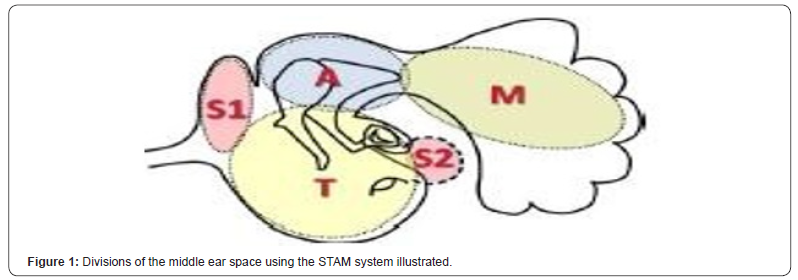
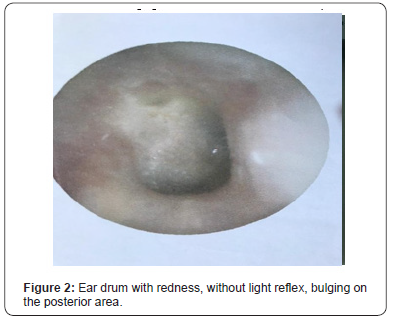
i. Classification of all Cholesteatomas Based on Pathogenesis: Cholesteatoma was classified as “congenital,” “acquired,” and “unclassifiable.” large or open cholesteatomas, it may not be possible to ascertain whether they are “congenital” or “acquired” [3]. The terms “primary acquired” and “secondary acquired” were dropped as historical terms and are confusing.
d. Acquired Cholesteatoma
It is further subclassified into
i. Retraction Pocket Cholesteatoma
a) Cholesteatoma
b) Pars tense cholesteatoma
c) Combination of pars flaccid and pars tense cholesteatoma
ii. Non-retraction Pocket Cholesteatoma
a) cholesteatoma secondary to tympanic perforation (the so-called secondary acquired cholesteatoma.
b) cholesteatoma following trauma and/or otologic procedures.
Post-surgical cholesteatoma may be residual or recurrent, although these are not mutually exclusive one of the most important characteristics is that cholesteatoma is the immense capacity to recur in direct relation with location, size and accuracy of the surgical procedure. Cholesteatoma recidivism includes- Residual cholesteatoma = incomplete surgical removal of the cholesteatoma matrix [4]. Recurrent cholesteatoma results from the reformation of the retraction pocket after a complete previous surgical cholesteatoma removal.
iii. Classification Based on Location in the Tympanic Cavity in Relation to the TM: The classification categorized, acquired cholesteatoma into retraction pocket cholesteatoma and non-retraction pocket cholesteatoma. The classification applies only to “Middle Ear Cholesteatoma” as the inclusion of petrous cholesteatoma makes the classification and staging system too complex [5]. The staging system reflects the severity of the cholesteatoma, the difficulty to achieve complete removal, and the subsequent restoration of the normal function.
iv. Divisions of the Middle Ear Space (STAM system): The original sites of PR tympanum, tympanic cavity, attic, and mastoid proposed by JOS were changed to STAM (S1: supratidal recess, S2: sinus tympanum- both to difficult access, tympanic cavity, attic, and mastoid) (Figure 1).
e. The EAONO/JOS Staging System Applies to Four Types of Middle Ear Cholesteatoma.
Pars flaccid cholesteatoma, Pars tense cholesteatoma, Congenital cholesteatoma, and Cholesteatoma secondary to a tense perforation (Table 3). The staging system does not apply to petrous bone cholesteatoma.

Case Report
A 12 years old girl was admitted in clinic for severe otalgia referred to the mastoid and temporal area, no discharge fever, headache, tinnitus, deafness on the same side and dizziness with vertigo and disequilibrium, nausea starting from a few days but without history of discharge or otalgia. She had no history of ear infections or surgery. Because the infection of the middle ear was recent, acute, without history of chronic suppurative otitis or surgeries on the eardrum like tympanotomy or trauma we diagnose congenital nature of the cholesteatoma [6]. Because the process starts 2 weeks before. We consider that it, was impossible for a cholesteatoma to grow in such a short time so for sure was congenital without symptoms till the infection. In fact her mother claim that at 6 years gold her daughter was diagnose with bilateral serous otitis , because she didn’t respond if she was called ,she prefer loud sounds at TV ,and the impression was that she is has a deficit of attention ,not capable to concentrate .After adenoidectomy and medical treatment seems to be OK but when I ask her if was tested –audiometry ,tympanometry she told me than the doctor just looks in the ears and test her with the tuning forks [7].
Also I insist if it was just adenoidectomy or placement of aerator in the eardrum but she denied and I believe her because in whose times older doctor where not dispose to learn and use new audiometry methods like acoustic immittance so they relayon clinical exam and tuning forks Just 10 months ago she start to accuse hyperacusis , tinnitus on the same ear and was examined by the family doctor and she follow a 10 days treatment with nasal steroids and an antiallergic ,antibiotic ,even instillations in the ear [8]. In the end she was send to an ENT specialist for examination and she was diagnosed with serous chronic otitis and was treated with nasal steroids ,Valsalva procedure and insufflation of the Eustachio tube, followed by adenoidectomy .After this procedure she admit that she can breathe better and she was convinced by the doctor that her hearing will improve step by step, just to be patient and chew gum (Figure 2 & 3). No auditory tests were required than. In the end after an episode of acute respiratory catarrhal infection on the night between 4-5 days from the beginning a severe otalgia appear on the right ear with extension on the mastoid process and temporal are, fever. At presentation in emergency was febrile 39, with an influence general status, ENT clinical examinations revealed that the skin on the mastoid right process was edematous and red and bulging without retro auricular sulcus, also on palpation the mastoid area was very painful on antral point, and fluctuant [9]. The auricle was pushed in front and inferior. Physical examination revealed mild pain upon compression of the left mastoid process, and occasional transient dizziness. Otoscopy and examination on the microscope, after complete cleaning the wax from the EAC using suction, reveal a red bulging eardrum without landmarks or perforations.
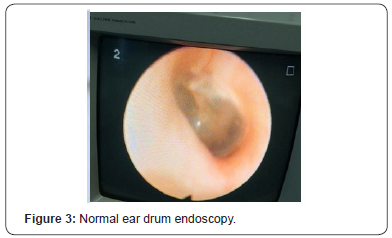
f. Laboratory Test
CBC, leukocytosis, neutrophilia, moderate anemia, thrombocytosis, PCR, ST higher than normal cultures from the nose pharynx, blood negative examination of the CN VII, VI, V normal nystagmus negative, vestibular tests normal [10].
g. Audiometry
Tuning fork test Rinne and Weber tests revealed a conductive hearing loss on the right ear. Pure tone audiometry demonstrates moderate conductive hearing loss with an air bone gap of 40dB on the right and normal hearing on the left. Tympanometry type B was found on the right and normal on the left (Figure 4 & 5).

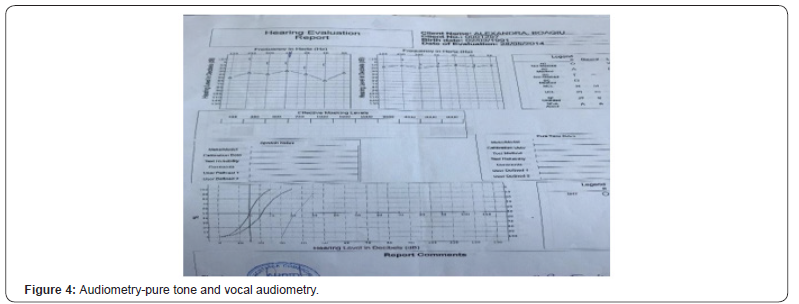
h. Imaging
X-Ray-lung normal, X-Rays of the mastoids –Schuller, Stenger’s were negative, CT scan of the head with contrast substance revealed – an extended mass occupying the entire mastoid process, adieus ad antrum and tympanic cavity, with negative intake of contrast substance and destruction of the septum between the mastoid cells also with erosion a on the antral region on the external cortical wall. No other bone erosion was present the sigmoid sinus, facial bones were normal. Magnetic resonance (MR) scan of the temporal bones, show an hypointense on T1- and hyperintense on T2- weighted images, with no postcontrast enhancement (Figure 6). Based on these results, she was admitted in the Clinic, we start the treatment with an association of 2 antibiotics with a good penetration in the bone, anti-inflammatory, analgesic, symptomatic, rehabilitation she was prepared for surgery in emergency required by the abscess formation (Figure 7). Under general anesthesia, the retro auricular abscess located subperiosteal was drained and the entire external cortical bone was expose for the mastoid exploration. Intraoperatively, there was a small Caria on the bone corresponding to the antrum [11]. Through the hole, pus mucopurulent nonfelid, and granulation tissue appeared when we explore the cavity with a curate. Step by step we discover a very large cholesteatoma occupying the middle ear, mastoid process and a half of the petrous part of the temporal bone. It was impossible to identify an ossicle, but the internal cortical bone was intact at the careful examination with the microscope, so there was no exposure of the dura (Figure 8 & 9). The tegmen tympani, round window and oval window were intact. There was no dehiscence of the facial canal along the tympanic segment. The vertical, tympanic and labyrinthine segments of the facial canal were intact and preserved also, sigmoid sinus or horizontal semicircular channel [12]. Because of the extension of the cholesteatoma, we succeed to remove it complete on, with a radical mastoidectomy, channel wall down tympani- mastoidectomy with a large meatoplasty for the best control of the remaining cavity. Because of high risk of recurrence, excision of the cholesteatoma at the microscope was extremely minutia’s removing the entire capsule of the cholesteatoma till the normal bone. Also, we washout the cavity with saline and peroxide and remove the necrotic tissue lining the abscess (Figure 10-13). At the end we pack the cavity with a gauze soaked in a local antibiotic for the hemostasis, to maintain a large opening of the meatoplasty and for the drainage.


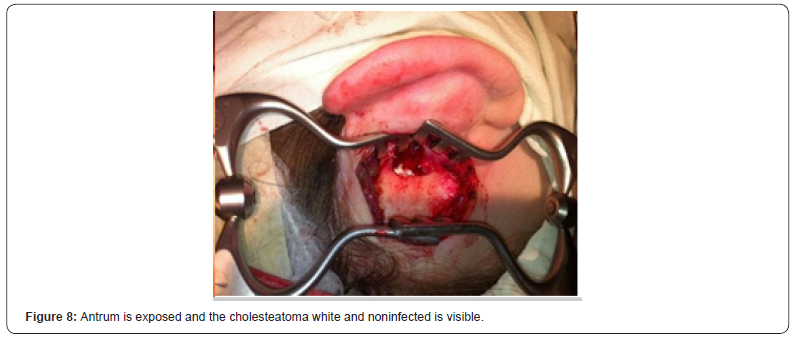
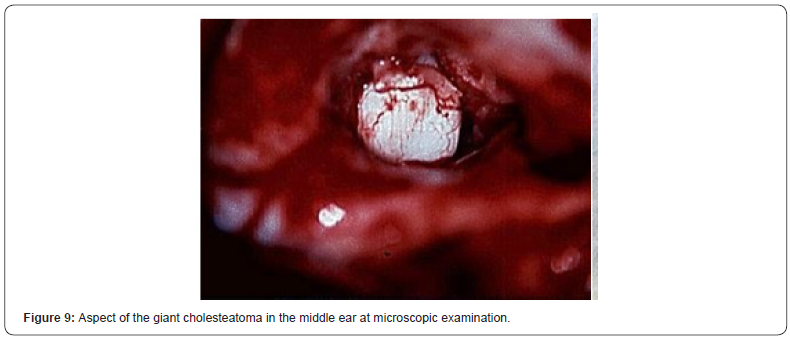

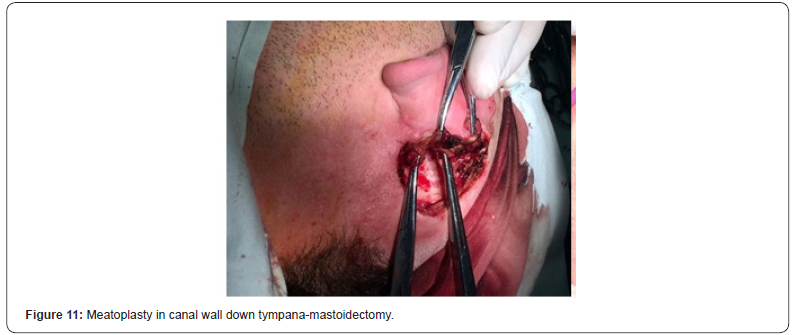
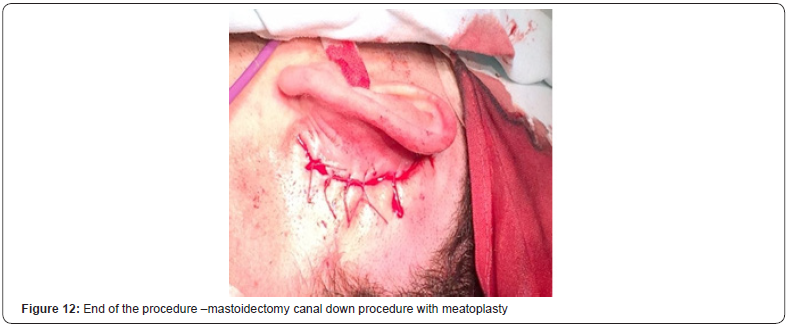
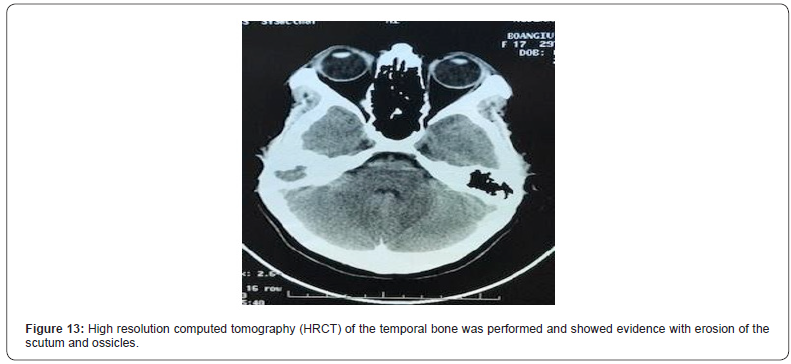
Postop, the evolution was good, without fever, vomiting, or dizziness just pain, and inherent difficulties of the daily treatment. General treatment remained unchanged with it he intravenous Rocephin and nitrocycline even after results of the bacteriologic test-Streptococcus pneumoniae –most sensible to the same drugs. Also, every day we change the dressing, but pack was left in place for 2 days than step by step we remove it from the cavity, using betadine, peroxide, saline to wash-out and clean finally the cavity with suction and using powders like boric acid or a local antibiotic like propamidine [13]. We remove the speeches on the 7 day, and she left the hospital 12 days after surgery, feeling good, just deafness and intermittent tinnitus on the ear persist but easy to support. She returns for another 2 weeks for cleaning the cavity using suction at the microscope, saline and instillation with antiseptics like betadine, peroxide and in the end, we left a local antibiotic, or antiseptic or antimycotic. 4 weeks after the procedure the entire cavity was clean, dry, bone covered with a normal mucosa. At home she was discharge with all the instruction required -to prevent water to protrude in the cavity, to avoid smoke, dust, cold, rain, without, loud noise, vibration [14]. Also, we instruct her to avoid cleaning herself the cavity with cotton swabs and to instigate local drops like Tabarded and Boric alcohol 3%.
After the complete healing we continue follow-up program with periodically cleaning of the cavity of was and epithelial debris at 1 month than 2-3 month, and we insist on possible problems and most important about high risk of recurrence of the cholesteatoma and infection [15]. In the next 2 years everything was normal including MRI repeated at 6-month, 1 year, 2 years. Than 4 year she disappeared but return suddenly accusing vertigo not very intense but permanent and tinnitus but now intense, acute, disturbing. She explains me that she was in Spain because the parents are working there, and she finished High school, and she work as a nurse. She was OK, so she didn’t need to be seen by a doctor, but the new symptoms start 2 months ago. Because she didn’t feel pain in the ear she first thinks at a pregnancy, that her family doctor suggest anemia, hypocalcemia (Figure 14). Because she returns at home for summer holiday, she came to visit me, so I insist in CT-scan control, even the ear remain dry.
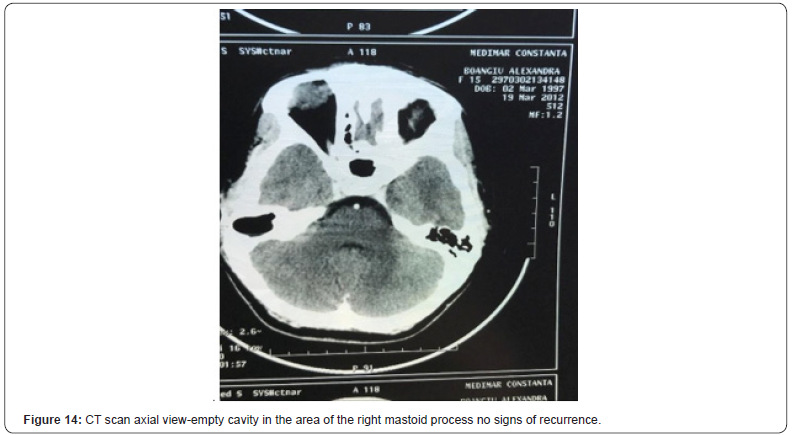
The CT scan revealed the recurrence of the cholesteatoma filling the mastoid and middle ear. A second surgery confirm the diagnosis but what was strange was that the old large-giant cavity was now very small, the external cortical of the mastoid was almost complete except a small hole in the antrum area. We proceed to another radical-channel wall-down tympanomastoidectomy, with, with, with minutia’s cleaning the membranes of cholesteatoma till we reach sane bone [16]. Also, we recreate the meatoplasty as large as possibilities evolution and healing were the same, except the vertigo. This symptom progressive disappears in 8 days, but she continues the treatment with Benthamite 6 months after the treatment. The immediate postoperative period was without complications and the patient reported no further dizziness at follow-up. However, she continues to describe a unilateral hearing deficit and a non-pulsatile tinnitus. Another unusual problem recurrent salivary lithiasis in both submaxillary glands. The follow-up program shows no recurrence and now after another 4 years is clean. She is now in care of a colleague from Spain, a very good sturgeon, and very interested by her case. He recently discusses with me about reconstruction at 5 years from the last surgery, with no signs of recurrence of cholesteatoma [17]. Also, I explained her about possibilities to improve the hearing, but she surprises as announcing her pregnancy, so we postpone the surgery. At the time of writing, the patient is a happy mother at a beautiful 5 months girl , and is feeling well ,without vertigo or tinnitus or discharge .Because the husband is also treated for stomatitis chronic with cholesteatoma but acquired type they are afraid for their child ,to develop a cholesteatoma ,but even if we know is possible ,we don’t know exactly how much are the chances It seems to me that most important is to prevent recurrent infection and increase immunity. Follow-up CT scan confirmed no recurrence and showed a large surgical cavity in the right mastoid process communicating with the antrum, adieus ad antrum, and tympanic cavity [18-23].
Discussion
Cholesteatoma was first described by Crueler in 1829 and named by Muller in 1858 but in fact Joseph-Guiscard DuVernay, a French anatomist, was the first to describe a temporal bone lesion in 1683 probably representing a cholesteatoma in 1953 House first describe a cholesteatoma behind an intact tympanic membrane. In 1838, German anatomist/pathologist Johannes Müller.name this pathology “cholesteatoma” (Greek: chole + steer = fat, coma = tumor). incorrect term because the lesion does not contain fat and is not of a neoplastic nature. Other term, more appropriate are “pearl tumor,” “margarita,” or “keratome,” but are not in use. The annual incidence of congenital cholesteatoma is 3/100 000 in children and 0.2-1,2 per 100 000 in adults. 4-24% of all cholesteatomas in children are congenital, usually beaning diagnosed between 2 to early teenage years old, with an average age of diagnosis of 4.5 years. In contrast, acquired cholesteatoma is more frequent after 10 years old predominantly at 40–70 years of age. A hereditary predisposition is recognized and about the sex there is no difference man-females. About the race is more frequent in white Caucasian individuals and very rare in Asian, American Indian, or Alaskan Eskimos.
i. Diagnosis of congenital cholesteatoma
Clinical criteria for the diagnosis of congenital cholesteatoma are established by Derlacki and Clemis in 1965 but after the revision made by Levenson are now complete. These are:
a) A pearly white mass medial to an intact tympanic membrane,
b) A normal pars tense and flaccid, and
c) No previous history of otorrhea or perforation of the eardrum,
d) Previous surgical procedure on the temporal bone or other local traumas.
Previous repeated acute otitis media or with effusion should not be the exclusion criteria. test from the reformation of the retraction pocket after a complete previous surgical cholesteatoma removal. The gravity of the disease depends on location, size, patients’ age, ossicular integrity, and complications. Only a perfect clinical exam and imaging-CT, MRI scan are capable give us such information’s. These variables represent the base for create a staging system for cholesteatomas unci and very useful for the surgeon to choose the best, appropriate surgical approach It is well accepted that CC behave in a more aggressive manner than the acquired form. The clinical presentation of a congenital cholesteatoma may be asymptomatic white mass behind an intact TM, in 82% of cases -usually found incidentally on a routine examination-otoscopy, on a CT/MRI scan, or during myringotomy procedures [23]. If the cholesteatomas grow large and in the middle ear became infected through the Eustachio tube, in both cases there is no history of ear disease, surgery or trauma of the temporal bone Eustachian tube obstruction, atelectasis of the middle ear, and reduced pneumatization of the mastoid.
In an advanced stage, congenital cholesteatomas cause the same symptoms as acquired one -Otorrhea-chronic fetid purulent discharge from the ear Hearing loss, most patients present with transmission or mixed hearing loss, less frequently with a dead ear. Tinnitus –is more intense in association with vertigo. Facial nerve palsy CN VII peripheral type in occurs in extensive cholesteatoma cases, is measured in House-Brackman grades Vertigo it’s a sign of inner ear sufferance, Earache, it’s always possible in activation of the infection or a complication like extermination type retro auricular abscess, cervical type Behold or on the posterior wall of the EAC type Gelled fistula or para- pharyngeal Headache is a less common manifestations, but can be a sign of thrombosis of lateral sinus or another complication ones.
Recurrence of the cholesteatomas after surgery is more commonly seen in larger lesions with osteitis. Acquired cholesteatomas are the more common type, characterized by destructive lesions within the middle ear and mastoid as a result of middle ear disease and/or Eustachian tube dysfunction not present at birth. A retraction pocket can develop into acquired cholesteatoma when it loses its ability of self-cleaning and starts the accumulation of keratin debris [24]. The retraction pocket of the pars flaccid, pars tense, or both and from basal cell invasion through the basilar membrane and could be a sequel of the dysfunction of middle ear pressure regulation. also develop secondary to tympanic membrane perforation as a result of previous chronic otitis media, trauma, or iatrogenic causes a retraction pocket can develop into acquired cholesteatoma when it loses its ability of self-cleaning and starts the accumulation of keratin debris.
j. Acquired Cholesteatomas
They are the more common type, characterized by destructive lesions within the middle ear and mastoid as a result of middle ear disease and/or Eustachian tube dysfunction is capable to destroy by (osteitis, pressure, and infection) structures within the middle ear and mastoid ossicular chain, Fallopian. channel of the VII CN, sigmoid sinus channel, horizontal semicircular channel, tegmen tympani, or antri promontories, internal external cortical bone of the mastoid process, with complications same risk of recurrence. Early diagnosis decreases the size of CC and subsequently decreases the incidence of complications. Early detection is possible via routine audiological or ontological screening or imagistic, also an unci classification system. Disease severity largely depends on location of the coliseum, age at the time of diagnosis, ossicular integrity, and number of sites involved. These factors have been borne out to have predictive value in probability of recidivism and recurrence, and they have been the basis of staging systems. These factors also can be used for predicting the need for imaging and for surgical planning.
k. Diagnosis
i. History: Is frequent a child with pain ,fever ,altered general status complaining of pain in one ear ,but also on the mastoid and temporal areas ,parents describe previously a common cold 4-5 days before with sub fever ,rhinorrhea and sore throat, ,than sudden at nigh a severe pain in the ear appear with high fever, headache etc. parents denied other episodes of otorrhea or traumas or previous surgeries on eardrum but in some cases there is a history of acute otitis or serous otitis.
ii. Clinical Examination: Reveal symptoms/signs that are the result of growth with/without destruction of the adjacent structures: Inspection, palpation-redness on the mastoid process, bulging, fluctuance in case of an otomastoiditis in complicated with retro auricular abscess-the auricle is pushed anterior and inferior. Always check the facial nerve VII and the neck otoscopy/ otomicroscopy/endoscopy-intact normal eardrum with a white mass most frequent in the antero-superior quadrant but can found in every quadrant, congestion of the eardrum without perforation perforation of the tympanic membrane most frequent in the antero-superior quadrant but can be found in every quadrant [25].
iii. Lab Tests: Including microbiology of the pus in case of otorrhea, or abscesses Audiometry –pure tone and vocal audiometry, immittances audiometry (If the eardrum is intact – reveal a hearing deterioration).
l. Imagistic
Stage I disease limited to the anterior superior quadrant whose full extent is seen by otoscopy typically does not require any further workup. Imaging is generally indicated if advanced disease (Stage III–IV) is present, if the full extent of disease cannot be seen by otoscopy, or if complications (facial paresis, otorrhea, or other cranial nerve deficits) are present.
i. HRCT (High Resolution): CT scan offer an excellent spatial resolution, because also perfect data about the size, location of the mass and the absence or presence of bony erosions. Of the ossicles and of the walls important like tegmen tympani but is incapable to offer information’s about the nature of the mass if is granulation tissue, secretion, cholesterol granuloma, or neoplasm. The absence of bony destruction does not exclude cholesteatoma, especially if the lesion is small. The CT is not specific for differentiating a cholesteatoma from the accompanying effusion or granulation tissue Also in a temporal bone having recurrence after an anterior surgery, CT is unable to accurately define the exact location and the extension of the lesion.
ii. MR Imaging:, Conventional Techniques: MR imaging provides a better tissue differentiation. The MR imaging signalintensity characteristics of cholesteatomas are not specific, usually hypointense/isointense on T1WI and hyperintense on T2WI compared with brain tissue. Granulation or scar tissue in an ear that already underwent surgery and bloody serous or proteinaceous fluid also show hyperintense signal intensity on T2. However, in a temporal bone having already undergone surgery, standard MR imaging sequences may not accurately detect cholesteatomas.
iii. MR Imaging: Novel Techniques: Diffusion-weighted single-shot spin-echo echo-planar sequences can be useful in the diagnosis of cholesteatomas. (congenital or acquired), they appear to have high signal intensity on DWI, attributed partly to restricted water diffusion (probably due to the oily consistency of the contained fluid) and predominantly to the T2 shine-through effect of the lesion as revealed by calculated apparent diffusion coefficient values. The most recent method for the diagnosis of recurrent cholesteatoma is the multishift fast spin-echo DWIPROPELLER -3 T technique. In summary, HRCT and MR imaging with DWI remain complementary examinations, which are both necessary in the accurate diagnosis of a recurrent/residual cholesteatoma to avoid unnecessary second-look operations. But also, in complications.
iv. Imagistic: X-Rays of the mastoid views Stenger’s, Schuller, Chausse are not useful now because a CT scan and MRI are able to show soft tissue mass –real extension othlesion, endocranial complications sometimes silent findings (thrombosis of the lateral sinus, intracranial abscesses,) focal areas of bony erosion of the middle ear, and mastoid cause for severe complications.
m. Pathophysiology
Four current theories exist explain the origin of congenital cholesteatoma but till now it’s still unclear. Implantation theory Friedberg, House and Sheehy, and Herdsman and Wright suggested that a possible rare cause of CC is implantation of squamous epithelium in the middle ear during ventilation tube insertion Northrop in 1986 described a theory of amniotic fluid implantation in the temporal bones. Via the Eustachian tube squamous epithelial cells migrated in the middle ear where they remain implanted most frequent in the anterosuperior quadrant. This theory is not sustained nothing proofs the ability of the cells to implant in other tissues.
i. Invagination Theory: By Rueda was emitted in 1959 when the origin of the cholesteatoma in a tympanic inflammation (otitis) in utero and neonatal life, this is the cause for invagination of the squamous epithelial cells into the Middle ear. Aimi in 1983 described the role of the tympanic ring as a barrier for migrating epithelial cells, a deficiency of this ring in certain locations provides a route for migration of squamous epithelial cells into the middle ear space. Further research on human embryonic -temporal bone has not supported this theory.
ii. Metaplasia: Is a theory by Sade in 1983 who sustain that in utero and neonatal period, inflammation can cause squamous metaplasia? Indeed, otitis media can cause keratinizing and nonkeratinizing metaplasia due to otitis media. The further research fails to explain the typical nature of these lesions, so this theory has no support
iii. Epidermoid Rests: Michaels in 1986 described a fourth and most plausible theory - the origin of a congenital cholesteatoma is in the epidermoid remaining cells within the middle ear. As a postpartum persistence of a fetal epithelial thickening medial to the malleus neck. This lesion is a distinct squamous cell nest with unknown function, which usually involutes to become normal endothelium. Lack of involution, for unknown reasons, can be the precursor of congenital cholesteatoma, which may form within the uterus or early in life. Congenital cholesteatomas can be associated with EAC atresia or, rarely, with first branchial cleft remnants. The persistence of these cells in the middle ear was sustained by researcher like Karmody-2007, Pot sic -2004, Richter, Liang -2009.
n. Natural History
Epithelial rests retained in the middle ear space naturally progress. Research reports depict that the most common location is anterior superior quadrant followed by posterior superior quadrant of the tympanic membrane. It is believed that these cholesteatomas behave in a more aggressive manner than the acquired form. Most cholesteatoma start out as a matrix enclosed spherical keratin pearl in the anterior superior quadrant. And growth is towards the eustachian tube, inferiorly towards the hypotympanum and posteriorly towards the handle of the malleus. Posterior growth may extend further, involving the incudostapedial joint and the stapes superstructure, as well as up towards the incudomalleolar joint, around the incus, and into the attic. The growth of CCs may progress from the attic into the antrum and then into the mastoid and follows the pattern of the enlargement of other categories of middle ear cholesteatomas. The lesions that start in the anterosuperior quadrant and grow anteriorly, where they can block the Eustachian tube and lead to otitis media with effusion (OME). Tympanic membrane rupture because of congenital cholesteatoma is controversial. Congenital cholesteatomas cause perforations in places other than the pars flaccid (typical location for acquired disease).
o. Complications
Labyrinthine fistula is the most frequent complication -5-10% associated with middle ear cholesteatoma, with a prevalence of 5%–10%. Episodic vertigo, sensorineural hearing loss, tinnitus, and the CT finding of a dehiscent lateral semicircular canal support the diagnosis. A dehiscence on the cochlear promontory is also possible but very rare. Fistula of the oval window might be suspected on HRCT when a stapes fragment is dislocated toward the vestibulum. Facial palsy may result from direct inflammatory effects, compression atrophy, very rarely from the presence of an inflammatory neuroma, and most often from erosion of the tympanic segment of the facial canal. However, bony dehiscence of the tympanic segment of the facial canal is a common variant present in 25%– 57% of cases. Perineural extension of a cholesteatoma along the facial nerve may also occur, in which case MR imaging is important, to exclude a neoplasm.
Sensorineural hearing loss develops by cholesteatomata’s involvement of the internal auditory canal. Total hearing loss may occur in the presence of a labyrinthine fistula causing labyrinthitis, which can be diagnosed by MR imaging showing enhancement of the membranous labyrinth. In these cases, CT is useful for demonstrating labyrinthine ossification ensuing in complicated or untreated cases. Thrombosis of the sigmoid sinus –visible on CT Anglo with erosion of the sinus plate and consecutive thrombosis. Intracranial complication like bacterial meningitis, and intracranial abscess –CT reveal tympanic tegmen erosion or bony defect, the same for the anterior wall of the epitympanum. Intracranial invasion requires an urgent MR imaging examination. A large bony defect of the epitympanum should raise the suspicion of an encephalocele or cholesteatoma extension in the middle cranial fossa, and MR imaging is recommended.
p. Differential Diagnosis
a) Cholesterol granuloma or Idiopathic blue eardrum.
b) Paragangliomas (appear otoscopic ally as pulsatile vascular masses behind the Tango CT and MR imaging are the choice, avoid biopsy.
c) Schwannomas of the facial nerve and geniculate ganglion.
d) Facial nerve hemangioma.
e) Eosinophilic granuloma of the middle ear or of the petrous bone is a tumor –a granulomatous disease Histiocytosis X.
f) Endolymphatic sac tumor with invasion of the inner or middle ear, or of the petrous part of the temporal bone,
g) Meningiomas in cerebella-pontine angle congenital cholesteatomas.
i. Histology: Cholesteatomas appear macroscopically as pearly gray or yellow well-circumscribed lesions. However, if accompanied by granulation tissue, they present with a soft waxy material, discolored by inflammatory changes Histologically, cholesteatomas display a squamous cell cyst representing an external matrix formed by a stratified strongly keratinizing squamous epithelium, which is like epidermal tissue elsewhere. The matrix produces abundant keratin lamellas, which are peeled off and pulled into the cyst. The matrix is usually accompanied by an adjacent external component containing collagenous and elastin fibers, mixed inflammatory cells, granulation tissue, and newly formed vessels called “peri matrix.” Bone fragments are often found within the peri matrix. Some studies reported deoxyribonucleic acid aneuploidy in cholesteatomas, but the widely accepted opinion is that cholesteatomas are not neoplasms. Nevertheless, association between middle ear cholesteatoma and squamous cell carcinoma (progression from cholesteatoma to squamous cell carcinoma) has been observed and reported in the literature. Bone erosion associated with cholesteatomas is reported in 80%–96% of cases, with a higher incidence in children than in adults and in pars flaccid than in pars tense cholesteatomas. Congenital cholesteatomas cause ossicular erosion less frequently, to a lesser extent, and later in the course of the disease than acquired cholesteatomas.
ii. Surgery: Surgery is the only Regardless of stage, treatment involves surgical excision. The approach varies with location and severity of disease. As for any cholesteatoma surgery, the priorities are preventing complications, early and complete removal of the lesion, profiting a safe and dry ear, preventing recurrence, and preserving/restoring hearing. The major approaches are: Extended tympanotomies, end aural atriotomies, sleeve tympanotomies, and end aural antrostomies for disease extending into the antrum without invasion of the mastoid cavity. A standard trans canal approach can be utilized with uncomplicated, early disease that is restricted to a single quadrant, but this only account for 20–30% of congenital cases. End aural approaches and postauricular approaches to the canal can aid in visualization but these also are limited to disease restricted to the ME. Stage I disease (no ossicular involvement) can often be treated with end aural approach and extended tympanotomies. Surgery for Stage II disease can often be treated similarly, but the presence of disease in the posterior quadrants is notoriously more difficult to treat. Trans canal antrostomy can be used to approach disease in posterior superior quadrant and antrum without mastoid invasion. Caution needs to be exercised with extension of disease into the sinus tympani and epitympanum, as trans canal approaches have limited access into these areas.
Stage III disease (ossicular without mastoid involvement) treated with extended tympanotomy plus possible scutum reduction or atriotomy showed a recurrence rate of 34– 41%. Stage IV disease (mastoid involvement) treated with tympanomastoidectomy showed a recurrence rate of 56–67%. Canal wall up mastoidectomy procedures are recommended for stage III–IV disease due to the high recurrence rate in these advanced diseased states. Ossicular erosion and mastoid involvement are correlated with a higher risk of recurrence (up to 67%). Mastoidectomy is recommended if there is involvement of greater than three subsites, presence of ossicular involvement, or extension into the antrum/mastoid. Second look procedures are rarely needed when early disease has been removed and when there is minimal or no ossicular involvement. Imaging or middle ear endoscopy may be useful when an increased risk of recurrence is suspected. Stage III–IV disease, due to the higher rate of recidivism, necessitates a second look procedure with possible ossicular reconstruction (OCR).
iii. The Following Strategies are Required For Hearing Reconstruction: Careful design and construction of the mastoid cavity partial obliteration of the mastoid cavity using a wide range of materials, bone dust, bone wax, muscle with pedicle, but many of these resorb in time-reconstruction of the ear canal wall using ear canal skin alone, fascia, cartilage, titanium as well as by replacing the original intact wall. If the reconstruction is poorly performed, it may result in a high rate of recurrent cholesteatoma, reconstruction of the tympanic membrane with fascia temporalis, perichondrium from tragus-reconstruction of the chain of hearing bones. Clearly, preservation and restoration of ear function at the same time as total removal of cholesteatoma requires a high level of surgical expertise.
q. Prognosis
Prognosis is quite good in early disease, but recurrence can approach 67% in advanced disease states (stage IV), often necessitating second look procedures and a long follow up with cleaning of the cavity of wax and epithelial debris and periodical imaging control. An unknown congenital cholesteatoma can be the cause of important. hearing loss –destruction of ossicular chain, inner ear involvement, but also complications like retro auricular exteriorization, intracerebral cerebral abscesses.
Conclusion
a) Congenital cholesteatoma is a pseudo tumoral, expansive mass, a very rare entity accounting for only 4-24% of all pediatric cholesteatomas. It’s benign by nature –epidermal cyst growing with slow progression Originating from the remnants of squamous keratinized epithelium located in the temporal bone that starts to grow, most frequent congenital cholesteatomas are located in the middle ear, mastoid process the petrous apex, cerebellopontine cistern, external acoustic meatus and between the layers if the eardrum.
b) The case presented was giant involving the entire middle ear, mastoid process and a part of the petrous process. Almost in all other cases we discover a congenital cholesteatoma occupied the entire mastoid process or only the antrum and middle ear.
c) Congenital cholesteatoma is very rare associate with other congenital anomalies of the external ear like stenosis or atresia of the of the external auditory channel. I have a single case of congenital cholesteatoma associated with microtia and stenosis of the EAC plus facial palsy, discovered late in a 45 years old lady because of an acute otitis with fast extension on the mastoid, retro auricular abscess and labyrinthitis. The case presented was strangely associated with recurrent salivary lithiasis but I as much as I review articles journals, I didn’t find a similar case. Plus, I cannot demonstrate if there is a relation between congenital cholesteatoma and salivary lithiasis.
d) The age of onset is around 3-6 years old. This is the moment when the cholesteatoma became symptomatic presenting most frequent as an acute otomastoiditis. My patients with congenital cholesteatoma were from infants till adults 45 years old. The age usually predicts severity of the disease, -ex over the age of 6 years the disease is more advanced. Our patient was 12 years old that’s why congenital cholesteatoma was so big.
e) Congenital cholesteatomas behave exactly like the acquired cholesteatomas that occur in the mastoid with the exception that they are no infected, so bone erosion and inflammation are rare. But after the infection usually through the Eustachio tube is impossible to differentiate the congenital from acquired types –they are included in unclassified category.
f) Almost in every case congenital cholesteatoma was discover suddenly as an acute otomastoiditis complicated with retro auricular abscess, or labyrinthitis, facial palsy, meningitis, thrombosis of the sigmoid sinus or IJV, In my career only in 2 cases-a 12 years old boy and a 5 years girl congenital cholesteatomas were discovered on a CT scan made for a craniofacial trauma but only excisional biopsy revealed that was not an eosinophilic granuloma.
g) In a single patient 18 years old cholesteatoma was discovered when this young student was admitted with fulminant otomastoiditis complicated with meningitis. The surprise was the CT scan –a compact mas s with destruction of the mastoid cells and erosion of the internal cortical of the mastoid process with an extradural abscess.
h) All the patient denied other infection of the middle ear or history of chronic suppurative otitis, chronic otorrhea, or surgeries on the eardrum like tympanotomy, placement of an aerator or trauma with perforation of the tympanic membrane and myringoplasty. Repeated cases of otitis media or serous otitis are not considered today criteria of exclusion for the diagnosis of congenital cholesteatoma.
i) They are described as a mass behind an intact eardrum, if they are in the middle ear. Most lesions (80%) appear in the anterior superior quadrant, but they can occur in any of the three other quadrants. Posterior quadrant disease often predicts a more difficult entity to treat. But if are infected the eardrum is modified the landmarks –light reflex, short process of the malleus are absent because of congestion and inflammation, the membrane is bulging or is not visible because of otorrhea, after cleaning the eardrum is perforated ,in the pars tens or flaccida. Even small the perforation is new with irregular, bleeding borders, and seroprotect blood stained pus is visible, pulsatile inside.
j) Imaging is indicated in case of complications (facial paresis, exteriorization, labyrinthitis or other cranial nerve deficits-VI, Vlore meningitis are present. Also, is essential in recurrence and evaluation of real extension, bone erosion. Imaging consist in high resolution CT scan –for the bone, and MRI for the inflammation and brain.
k) The reality is that 20 years ago CT scan was a dream, so we rely on an x-Ray of the mastoid like Schuller Stenger’s or Chausse III views but difficult to do and read so the diagnosis was an intracortical discovery. 10. Severity of the disease depends on location, patients’ age, ossicular integrity, and number of anatomic sites involved. These variables have inspired the development of staging systems whereby appropriate surgical approaches can be designed. Computed tomography is necessary and continue to be the best radiographic tool for surgical planning
l) Surgery is the only method of treatment and must be adapted to the extent and location of disease. Early single quadrant disease can often be treated with simple end aural procedures like atriotomy. Extended tympanotomy procedures can preclude mastoidectomy if the full extent of disease can be accessed and removed. Canal wall up mastoidectomy should be performed if greater than three subsites are involved, presence of ossicular involvement, or extension into the antrum/mastoid. Canal wall down procedures are rarely needed and only indicated in failure of procedures, severe canal wall defects initially, labyrinthine fistula, poor health/compliance, sclerotic mastoid, or only one hearing ear.
m) Prognosis is quite good in early disease, but recurrence can approach 67% in advanced disease states (stage IV), often necessitating second look procedures and a long follow up. This case needs for the future long-term surveillance, and periodically cleaning of the mastoidectomy cavity because of high risk of recurrence of the cholesteatoma.
Congenital cholesteatoma even very rare is a potential very dangerous disease so early detection of the primary mass or of the recurrence is important. The consequences of undiagnosed, untreated cholesteatoma can be significant. Hearing loss, complications like retro auricular exteriorization, meningitis cerebral abscesses. In the end with all our new imagistic devices, better surgical instruments, microscopy, endoscopy, our contemporary understanding about congenital cholesteatoma remains limited. controversial, for all otologist this disease it is a challenge in diagnosis also surgically, requiring great effort to remove the lesion, prevent recurrence and restore the hearing.
References
- Aimi K (1983) Role of the tympanic ring in the pathogenesis of congenital cholesteatoma. Laryngoscope 93: 1140-1146.
- Bruning JL, Kintz BL (1997) Computational Handbook of Statistics. White Plains, Longman Publishing, NY, pp. 286-289.
- Derlacki EL, Clemis JD (1965) Congenital cholesteatoma of the middle ear and mastoid. Ann Otol Rhinol Laryngol 74: 706-727.
- Dubrulle F, Souillard R, Chechin D,VaneeclooFM, Desaulty A, et al. (2006) Diffusion weighted MR imaging sequence in the detection of postoperative recurrent cholesteatoma. Radiology 238: 604-610.
- De Souza CE, Sperling NM, Da Costa SS, Yoon TH, Adbel Hamid M, et al. (1989) Congenital cholesteatomas of the cerebropontine angle. Am J Otol 10: 358-363.
- Friedberg J (1994) Congenital cholesteatoma. Laryngoscope 104(2): 1-24.
- Fisch U (1977) Infratemporal fossa approach for extensive tumors of the temporal bone and base of skull. In: In: Silverstein H, Norell N, editor. Neurological Surgery of the Ear. Birmingham, Aesculapius, AL, USA, pp. 5333-5350.
- Fisch U (1994) Tympanoplasty, Mastoidectomy, and Stapes Surgery. Georg Thieme, Stuttgart, Germany.
- House JW, Sheehy JL (1980) Cholesteatoma with intact tympanic membrane: a report of 41 cases. Laryngoscope 90: 70-76.
- House HP (1953) An apparent primary cholesteatoma: case report. Laryngoscope 63(8): 712-26. Proctor B (1991) Chronic otitis media in mastoiditis. In: Paparella MM, Shumrick DA (Eds.). Otolaryngology the Ear. (3rd edn.), Philadelphia: WB Saunders 2: 1366-844.
- House JW, Brackmann DE (1985) Facial nerve grading system. Otolaryngol Head Neck Surg 93: 146-147.
- House W F, De La Cruz A, Hitselberger W E (1978) Surgery of the skull base: transcochlear approach to the petrous apex and clivus. Otolaryngology 86: 770-779.
- House WF, Hitselberger WE (1976) The transcochlear approach to the skull base. Arch Otolaryngol 102: 334-342.
- Jeunen G, Desloovere C, Hermans R, Vandecaveye V (2008) The value of magnetic resonance imaging in the diagnosis of residual or recurrent acquired cholesteatoma after canal wall-up tympanoplasty. Otol Neurotol 29(1): 16-18.
- Karmody CS, Byahatti SV, Blevins NV, Altonen H, Northrop C, et al. (1998) The origin of congenital cholesteatoma. Am J Otol 19:292-297.
- Levenson MJ, Michaels L, Parisier SC, Juarbe C (1989) Congenital cholesteatomas in children: an embryologic correlation. Laryngoscope 98: 949-955.
- Lehmann P, Saliou G, Brochart C (2009) 3T MR imaging of postoperative recurrent middle ear cholesteatomas: value of periodically rotated overlapping parallel lines with enhanced reconstruction diffusionweighted MR imaging. AJNR Am J Neuroradiol 30: 423-427.
- Michaels L (1986) An epidermoid formation in the developing middle ear: possible source of cholesteatoma. J Otolaryngol 15: 169-174.
- Mc Gill TJ, Merchant S, Healy GB, Friedman EM (1991) Congenital cholesteatoma of the middle ear in children: A clinical and histopathological report. Laryngoscope 101: 606-613.
- Nelson M, Roger G, Koltai, Peter J (2002) Congenital cholesteatoma: classification, management, and outcome. Arch Otolaryngol Head Neck Surg 128: 810-814.
- Nishizaki K, Yamamoto S, Fukazawa M, Yuen KOhmichi T, Masuda Y, et al. (1996) Bilateral congenital cholesteatoma. Int J Pediatr Otorhinolaryngol 34: 259-264.
- Peron DL, Schuknecht HF (1975) Congenital cholesteatoma with other anomalies. Arch Otolaryngol 101: 498-505.
- Sade J, Babiacki A, Pincus G (1983) The metaplastic and congenital origin of cholesteatoma. Acta Otolaryngol 96:119-129.
- Tos M A (1897) new pathogenesis of mesotympanic (congenital) cholesteatoma. Laryngoscope 110: 1890-1897.
- Justyna Rutkowska, Nuri Özgirgin, Ewa Olszewska (2017) Cholesteatoma Definition and Classification: A Literature Review .Journal International of Advanced Otology 13: 266-271.





























